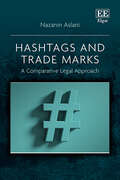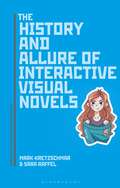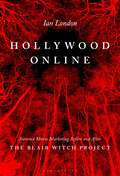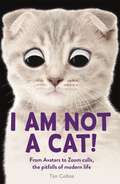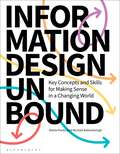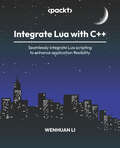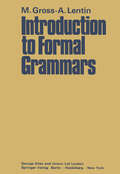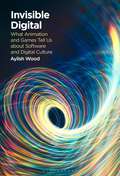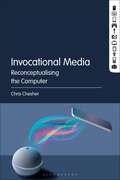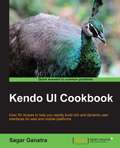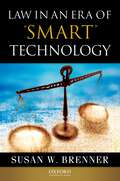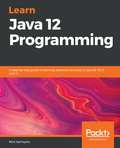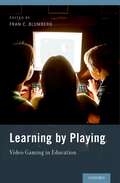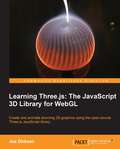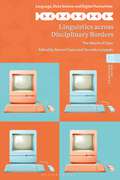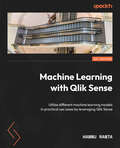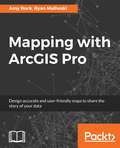- Table View
- List View
Hashtags and Trade Marks: A Comparative Legal Approach
by Nazanin AslaniThis timely book examines the growing importance of hashtags both in online culture and within our digital society. Conducting a comparative analysis of legal strategies within the EU, Germany, and the United States, it aims to ascertain whether a fair balance currently exists between freedom of expression and competition in the treatment of hashtags as trade marks. Nazanin Aslani firstly introduces a novel taxonomy of hashtags, highlighting their multifaceted functions, which goes beyond their commercial value to encompass their expressive, communicative, and organisational aspects. The book then highlights the need for a deeper understanding of hashtag functions, arguing that this lack of understanding has led to mischaracterisation by courts and registries, which in turn has led to contradictory case outcomes. Featuring an extensive analysis, this book advocates for strong fair use defences to maintain a balance between protection and free expression, competition, and internet regulation and deregulation. Providing a unique focus on this evolving subject, Hashtags and Trade Marks will be an excellent resource for academics of comparative trade mark, unfair competition and intellectual property law. Practitioners, policy makers and in-house counsel will also benefit from this book to fill in knowledge gaps surrounding hashtags and provide solutions for organisational devices used as trade marks yet to be developed.
The History and Allure of Interactive Visual Novels (Approaches to Digital Game Studies)
by Dr. Mark Kretzschmar Dr. Sara RaffelVisual novels (VNs), a ludic video game genre that pairs textual fiction stories with anime-like images and varying degrees of interactivity, have increased in popularity among Western audiences in recent years. Despite originating in Japan, these stories have made their way into global culture as a genre accessible for both play and creation with wide-ranging themes from horror and loneliness to sexuality.The History and Allure of Interactive Visual Novels begins with a comprehensive overview of the visual novel genre and the cultural evolution that led to its rise, then explains the tropes and appeal of subgenres like bishojo (cute girl games), detective games, horror, and eroge (erotic games). Finally, the book explores the future of the genre in both user-generated games and games from other genres that liberally borrow both narrative and ludological themes from visual novels. Whether you're a long-standing fan of the genre or a newcomer looking for a fresh experience, The History and Allure of Interactive Visual Novels will provide an accessible and critically engaging overview of a genre that is rich in storytelling yet often overlooked.
Hollywood Online: Internet Movie Marketing Before and After The Blair Witch Project
by Dr. Ian LondonHollywood Online provides a historical account of motion picture websites from 1993 to 2008 and their marketing function as industrial advertisements for video and other media in the digital age.The Blair Witch Project is the most important example of online film promotion in cinema history. Over the last thirty years only a small number of major and independent distributors have converted internet-created buzz into box-office revenues with similar levels of success. Yet readings of how the film's internet campaign broke new ground in the summer of 1999 tend to minimize, overlook or ignore the significance of other online film promotions. Similarly, claims that Blair initiated a cycle of imitators have been repeated in film publications and academic studies for more than two decades. This book challenges three major narratives in studies about online film marketing: Hollywood's major studios and independents had no significant relationship to the internet in the 1990s; online film promotions only took off after 1999 because of Blair; and Hollywood cashed-in by initiating a cycle of imitators and scaling up corporate activities online. Hollywood Online tests these assumptions by exploring internet marketing up to and including the film's success online (Pre-Blair, 1993-9), then by examining the period immediately after Blair (Post-Blair, 2000-8) which broadly coincides with the rise and decline of DVD, as well as the emergence of the social media sites MySpace, Facebook and Twitter.
How to Use Microsoft® Excel®
by Joseph M. ManzoHow to Use Microsoft® Excel® The Careers in Practice Series is an textbook appropriate for a course covering Microsoft Excel at a beginner to intermediate level. It is geared toward and will be accommodating for students and instructors with little to no experience in using Microsoft Excel. However, the approach is not at the expense of relevance. How to Use Microsoft® Excel® The Careers in Practice Series approaches Excel from the perspective of making personal and professional quantitative decisions. Personal decisions include big purchases such as homes and automobiles, savings for retirement, and personal budgets. Professional decisions include budgets for managing expenses, merchandise items to markdown or discontinue, and inventory management.
How to Use Microsoft® Excel® version 1.1
by Joseph M. ManzoHow to Use Microsoft® Office Excel® The Careers in Practice Series V. 1.1 is an textbook appropriate for a course covering Microsoft Excel at a beginner to intermediate level. It is geared toward and will be accommodating for students and instructors with little to no experience in using Microsoft Excel. However, the approach is not at the expense of relevance. How to Use Microsoft® Excel® The Careers in Practice Series approaches Excel from the perspective of making personal and professional quantitative decisions. Personal decisions include big purchases such as homes and automobiles, savings for retirement, and personal budgets. Professional decisions include budgets for managing expenses, merchandise items to markdown or discontinue, and inventory management.
I Am Not a Cat!: From Avatars to Zoom Calls, the Pitfalls of Modern Life
by Tim CollinsIf you’re fed up with technology and sick to death of Zoom calls, this is the laugh-out-loud book for you.We’ve all had to get used to a different way of life in one way or another, whether it’s food deliveries or online banking, technology is taking over – and not always in a good way. But, as this hilarious book shows, there are plenty of examples of tasks – which were once straightforward and now need a degree in computer science – that have wonderfully unintended consequences. From funny Zoom calls such as that endured by the poor Texan lawyer who couldn’t turn off his cat filter, to wilful wifi that cuts you off in mid-stream and from ‘smart’ TVs that outsmart you every time to excruciating Teams calls that make your colleagues wince and titter, I Am Not a Cat! is a call-to-arms for everyone frustrated with twenty-first century living.
Implementing DevSecOps Practices: Supercharge your software security with DevSecOps excellence
by Vandana SehgalGet to grips with application security, secure coding, and DevSecOps practices to implement in your development pipelineKey FeaturesUnderstand security posture management to maintain a resilient operational environmentMaster DevOps security and blend it with software engineering to create robust security protocolsAdopt the left-shift approach to integrate early-stage security in DevSecOpsPurchase of the print or Kindle book includes a free PDF eBookBook DescriptionDevSecOps is built on the idea that everyone is responsible for security, with the goal of safely distributing security decisions at speed and scale to those who hold the highest level of context. This practice of integrating security into every stage of the development process helps improve both the security and overall quality of the software. This book will help you get to grips with DevSecOps and show you how to implement it, starting with a brief introduction to DevOps, DevSecOps, and their underlying principles. After understanding the principles, you'll dig deeper into different topics concerning application security and secure coding before learning about the secure development lifecycle and how to perform threat modeling properly. You’ll also explore a range of tools available for these tasks, as well as best practices for developing secure code and embedding security and policy into your application. Finally, you'll look at automation and infrastructure security with a focus on continuous security testing, infrastructure as code (IaC), protecting DevOps tools, and learning about the software supply chain. By the end of this book, you’ll know how to apply application security, safe coding, and DevSecOps practices in your development pipeline to create robust security protocols.What you will learnFind out how DevSecOps unifies security and DevOps, bridging a significant cybersecurity gapDiscover how CI/CD pipelines can incorporate security checks for automatic vulnerability detectionUnderstand why threat modeling is indispensable for early vulnerability identification and actionExplore chaos engineering tests to monitor how systems perform in chaotic security scenariosFind out how SAST pre-checks code and how DAST finds live-app vulnerabilities during runtimePerform real-time monitoring via observability and its criticality for security managementWho this book is forThis book is for DevSecOps engineers and application security engineers. Developers, pentesters, and information security analysts will also find plenty of useful information in this book. Prior knowledge of the software development process and programming logic is beneficial, but not required.
Information Design Unbound: Key Concepts and Skills for Making Sense in a Changing World
by Dr Sheila Pontis Michael BabwahsinghAs everyday tasks grow more confusing, and as social and global problems grow more complex, the information designer's role in bringing clarity has reached a new level of importance. In order to have a positive impact, they must go beyond conventional approaches to uncover real needs, make insightful connections, and develop effective solutions. Information Design Unbound provides a clear, engaging introduction to the field, and prepares students to be strategic thinkers and visual problem solvers who can confidently make sense in a changing world.Sheila Pontis and Michael Babwahsingh present a holistic view of information design, synthesizing decades of research, cross-disciplinary knowledge, and emerging practices. The book opens by laying a foundation in the field, first painting the bigger picture of what it is and how it originated, before explaining the scientific and cultural dimensions of how people perceive and understand visual information. A discussion of professional practices, ethical considerations, and the expanding scale of challenges sheds light on the day-to-day work of information designers today. Detailed chapters then delve into the four areas that are integral to all types of information design work: visual thinking, research, sensemaking, and design. The final section of the book puts everything together, with detailed project walk-throughs in areas such as icon design, instructions, wayfinding, organizational strategy, and healthcare system change.Written and designed with students' needs in mind, this book brings information design fundamentals to life: exercises allow students to put lessons directly into practice, case studies demonstrate how information designers think and work, and generous illustrations clarify concepts in a visually engaging way.Information Design Unbound helps beginning designers build the mindset and skillset to navigate visual communication challenges wherever they may arise.
Information Rights: A Practitioner's Guide to Data Protection, Freedom of Information and Other Information Rights
by Mr Philip Coppel KC“An essential addition to the bookshelf of any practitioner who has to consider information rights, however often. The book is the best kind of practitioner text: practical and clear, but also scholarly, thoughtful and analytical.” (Sarah Hannett KC, Judicial Review)Retaining the position it has held since first publication, this is the 6th edition of the leading practitioner text on all aspects of information law. The latest edition includes a substantially enlarged set of chapters on appeals, enforcement, and remedies, as well as covering over 250 new judgments and decisions published since the last edition.Information Rights has been cited by the Supreme Court, Court of Appeal and the Tribunals, and is used by practitioners, judges and all those who practise in the field, including journalists. The new edition maintains its style of succinct statements of principle, supported by case law, legislative provisions, and statutory guidance.The work is divided into 2 volumes. Volume 1 is a 1,500-page commentary, with a comprehensive coverage of the data protection regime, freedom of information and environmental information law, as well as other rights of access to official information such as local government legislation and the Public Records Act. There is detailed coverage of appeal and regulatory procedures. Volume 2 comprises extensive annotated statutory material, including the DPA 2018, the UK GDPR, FOIA, Tribunal rules and statutory guidance.Contributors: James Findlay KC, Olivia Davies, John Fitzsimons, Richard Hanstock and Dr Christina Lienen (all of Cornerstone Barristers); Antony White KC, Sarah Hannett KC, Sara Mansoori KC and Aidan Wills (all of Matrix Chambers); Aidan Eardley KC and Clara Hamer (both of 5RB); Rupert Bowers KC and Martin Westgate KC (both of Doughty Street Chambers); Henry King KC and Bankim Thanki KC (both of Fountain Court Chambers); James Maurici KC and Jacqueline Lean (both of Landmark Chambers); Gemma White KC (Blackstone Chambers); Oliver Sanders KC (1 Crown Office Row); Saima Hanif KC (3VB); Jennifer Thelen (39 Essex Chambers); and Simon McKay (McKay Law).
Information Systems: A Manager's Guide to Harnessing Technology version 1.2
by John GallaugherInformation Systems: A Manager's Guide to Harnessing Technology V1.2 is intended for use in undergraduate and/or graduate courses in Management Information Systems and Information Technology. Version 1.2 of John's book retains the same structure and theory of version 1.1, but refreshes key statistics, examples, and brings case material up to date (vital when covering firms that move as fast as Facebook, Google, and Netflix). Adopting version 1.2 guarantees your students will have the most current text on the market, drawing real and applicable lessons from material that will keep your class offerings current and accessible.
Information Systems: A Manager's Guide to Harnessing Technology version 1.3
by John GallaugherInformation Systems: A Manager's Guide to Harnessing Technology V 1.3 is intended for use in undergraduate and/or graduate courses in Management Information Systems and Information Technology. Version 1.3 of John's book retains the same structure and theory of version 1.1 and V 1.2, but refreshes key statistics, examples, and brings case material up to date (vital when covering firms that move as fast as Facebook, Google, and Netflix). For example; the Netflix chapter - Updates address the major changes impacting Netflix in 2011, including the response to the firm's pricing changes, the failed Qwikster service split, recent developments impacting the streaming and DVD-by-mail businesses, a comparison table detailing the stark differences between the firm's two offerings (DVD & streaming), updated statistics, learning objectives, and additional exercises and updates to the Google chapter - Updated text/images for currency, additional sub-sections on the firm's Google+ launch and the acquisition of Motorola Mobility. Adopting version 1.3 guarantees your students will have the most current text on the market, drawing real and applicable lessons from material that will keep your class offerings current and accessible.
Information Systems: A Manager's Guide to Harnessing Technology version 1.4
by John GallaugherInformation Systems: A Manager’s Guide to Harnessing Technology V 1.4 is intended for use in undergraduate and/or graduate courses in Management Information Systems and Information Technology. Version 1.4 of John's book retains the same structure and theory of the earlier versions, but Version 1.4 updates key statistics and examples, and includes up-to-date case material, such as Pinterest and Facebook’s Instagram acquisition. Adopting version 1.4 guarantees your students will have the most current text on the market, drawing real and applicable lessons from material that will keep your class offerings current and accessible.
Integrate Lua with C++: Seamlessly integrate Lua scripting to enhance application flexibility
by Wenhuan LiDiscover the perfect synergy between C++ and Lua to create powerful, adaptable, and high-performing software solutionsKey FeaturesGet hands-on experience by integrating Lua with C++Explore real-life project-ready advanced techniques for your future projectsLearn Lua through practical coding examples and exercisesPurchase of the print or Kindle book includes a free PDF eBookBook DescriptionC++ is a popular choice in the developer community for building complex and large-scale performant applications and systems. Often a need arises to extend the system at runtime, without recompiling the whole C++ program. Using a scripting language like Lua can help achieve this goal efficiently. Integrate Lua to C++ is a comprehensive guide to integrating Lua to C++ and will enable you to achieve the goal of extending C++ programs at runtime. You’ll learn, in sequence, how to get and compile the Lua library, the Lua programming language, calling Lua code from C++, and calling C++ code from Lua. In each topic, you’ll practice with code examples, and learn the in-depth mechanisms for smooth working. Throughout the book, the latter examples build on the earlier ones while also acting as a standalone. You’ll learn to implement Lua executor and Lua binding generator, which you can use in your projects directly with further customizations. By the end of this book, you’ll have mastered integrating Lua into C++ and using Lua in your C++ project efficiently, gained the skills to extend your applications at runtime, and achieved dynamic and adaptable C++ development.What you will learnExplore how to access and compile Lua source codeCall Lua code from C++ for enhanced functionalityIntegrate C++ code into Lua for powerful interactionsDeepen your understanding of Lua stack for advanced usageImplement a project-ready Lua executor and binding generatorExtend C++ projects with customizable and extensible Lua scriptingWho this book is forThis book is for C++ developers seeking to seamlessly integrate Lua, learn the Lua programming language by examples, or enhance their understanding of Lua-C++ interaction. Basic knowledge of C++ is required to fully benefit from this book.
Invisible Digital: What Animation and Games Tell Us about Software and Digital Culture
by Aylish WoodInvisible Digital helps us makes sense of something we cannot see by presenting an innovative approach to digital images and digital culture. At its heart is a novel method for exploring software used in the creation of moving images as markers of converging cultural, organizational and technological influences. The three main case studies of Invisible Digital are the animated feature Moana (2016) and the computer games No Man's Sky (2016) and Everything (2017). All three were created using procedural techniques: simulation software for Moana, and procedural content generation for No Man's Sky and Everything. Production culture disclosures associated with procedural techniques often emphasize the influences of automated systems and their algorithms, making them ideal for a study that interrogates digital processes. The approach of Invisible Digital is informed by relational theories and the concept of entanglement based on materialist perspectives, combined with insights from work that more explicitly interrogates algorithms and algorithmic culture. Aylish Wood employs the notion of assemblages to introduce the concept of material-cultural narratives. Using this conceptual framework, she draws out material-cultural narratives for each case study to demonstrate what they reveal about software and digital culture. These analyses of software provide a widely applicable method through which moving image studies can contribute more fully to the wider and growing debates about algorithmic culture.
Invocational Media: Reconceptualising the Computer
by Dr. Chris ChesherInvocational Media critiques the sociotechnical power of digital technologies by introducing the concept of invocational media.What is an invocation? Ask your voice assistant and it will define it for you. It is a media artefact that responds to many invocations such as seeking the weather forecast, requesting any song you can name, or turning on the lights, almost magically. This contemporary manifestation of the ancient practice of invocation gives an immediate response to your call in a way that Chris Chesher argues is the characteristic power of all computers, which he redefines as invocational media.This book challenges the foundations of computer science by offering invocation as a powerful new way of conceptualising digital technologies. Drawing on media philosophy, Deleuze, Guattari, Heidegger, Latour, Austin, Innis and McLuhan, it critiques the representationalism of data processing, artificial intelligence and virtual reality. Invocational media seem to empower individuals, but necessarily subject users to corporate and government monopolies of invocation. They offer many 'solutions', but only by reducing everything to the same kind of act. They complicate agency in their indifference as to whether invokers are human or non-human. With robotics they invoke material form to act physically and autonomously. People willingly make themselves invocable to surveillance and control by creating their own profiles and marking themselves with biometrics. This ground-breaking book will change how you think about digital media by showing they are, in fact, invocational media.
Kendo UI Cookbook
by Sagar GanatraThis book is an easy-to-follow guide full of hands-on examples that allows you to learn and build visually compelling web applications using the Kendo UI library. This book will do wonders for web developers having knowledge of HTML and Javascript and want to polish their skills in building applications using the Kendo UI library.
Learn Java 12 Programming: A Step-by-step Guide To Learning Essential Concepts In Java Se 10, 11, And 12
by Nick SamoylovLearning Geospatial Analysis with Python: Unleash the power of Python 3 with practical techniques for learning GIS and remote sensing
by Joel LawheadHarness the powerful Python programming language to navigate the realms of geographic information systems, remote sensing, topography, and more, while embracing a guiding framework for effective geospatial analysisKey FeaturesCreate GIS solutions using the new features introduced in Python 3.10Explore a range of GIS tools and libraries, including PostGIS, QGIS, and PROJIdentify the tools and resources that best align with your specific needsPurchase of the print or Kindle book includes a free PDF eBookBook DescriptionGeospatial analysis is used in almost every domain you can think of, including defense, farming, and even medicine. In this special 10th anniversary edition, you'll embark on an exhilarating geospatial analysis adventure using Python. This fourth edition starts with the fundamental concepts, enhancing your expertise in geospatial analysis processes with the help of illustrations, basic formulas, and pseudocode for real-world applications. As you progress, you’ll explore the vast and intricate geospatial technology ecosystem, featuring thousands of software libraries and packages, each offering unique capabilities and insights. This book also explores practical Python GIS geospatial applications, remote sensing data, elevation data, and the dynamic world of geospatial modeling. It emphasizes the predictive and decision-making potential of geospatial technology, allowing you to visualize complex natural world concepts, such as environmental conservation, urban planning, and disaster management to make informed choices. You’ll also learn how to leverage Python to process real-time data and create valuable information products. By the end of this book, you'll have acquired the knowledge and techniques needed to build a complete geospatial application that can generate a report and can be further customized for different purposes.What you will learnAutomate geospatial analysis workflows using PythonUnderstand the different formats in which geospatial data is availableUnleash geospatial tech tools to create stunning visualizationsCreate thematic maps with Python tools such as PyShp, OGR, and the Python Imaging LibraryBuild a geospatial Python toolbox for analysis and application developmentUnlock remote sensing secrets, detect changes, and process imageryLeverage ChatGPT for solving Python geospatial solutionsApply geospatial analysis to real-time data tracking and storm chasingWho this book is forThis book is for Python developers, researchers, or analysts who want to perform geospatial modeling and GIS analysis with Python. Basic knowledge of digital mapping and analysis using Python or other scripting languages will be helpful.
Learning Three.js: The Javascript 3d Library For Webgl
by Jos Dirksen“Learning Three.js is a hands-on guide which provides everything you need to start working with the powerful JavaScript library, and start creating awesome in-browser visualizations”.Learning Three.js is written for anyone looking to get started with Three.js, or looking to improve their skills with the popular js library. The book assumes some knowledge of javascript, but you don't need any knowledge of Three.js itself to follow the book.
Linguistics across Disciplinary Borders: The March of Data (Language, Data Science and Digital Humanities)
This volume highlights the ways in which recent developments in corpus linguistics and natural language processing can engage with topics across language studies, humanities and social science disciplines.New approaches have emerged in recent years that blur disciplinary boundaries, facilitated by factors such as the application of computational methods, access to large data sets, and the sharing of code, as well as continual advances in technologies related to data storage, retrieval, and processing. The “march of data” denotes an area at the border region of linguistics, humanities, and social science disciplines, but also the inevitable development of the underlying technologies that drive analysis in these subject areas.Organized into 3 sections, the chapters are connected by the underlying thread of linguistic corpora: how they can be created, how they can shed light on varieties or registers, and how their metadata can be utilized to better understand the internal structure of similar resources. While some chapters in the volume make use of well-established existing corpora, others analyze data from platforms such as YouTube, Twitter or Reddit. The volume provides insight into the diversity of methods, approaches, and corpora that inform our understanding of the “border regions” between the realms of data science, language/linguistics, and social or cultural studies.
Machine Learning with Qlik Sense: Utilize different machine learning models in practical use cases by leveraging Qlik Sense
by Hannu RantaMaster the art of machine learning by using the one-of-a-kind Qlik platform, and take your data analytics skills to the next levelKey FeaturesGain a solid understanding of machine learning concepts and learn to effectively define a problemExplore the application of machine learning principles within the Qlik platformApply your knowledge of ML to real-world scenarios with the help of practical examplesPurchase of the print or Kindle book includes a free PDF eBookBook DescriptionThe ability to forecast future trends through data prediction, coupled with the integration of ML and AI, has become indispensable to global enterprises. Qlik, with its extensive machine learning capabilities, stands out as a leading analytics platform enabling businesses to achieve exhaustive comprehension of their data. This book helps you maximize these capabilities by using hands-on illustrations to improve your ability to make data-driven decisions. You’ll begin by cultivating an understanding of machine learning concepts and algorithms, and build a foundation that paves the way for subsequent chapters. The book then helps you navigate through the process of framing machine learning challenges and validating model performance. Through the lens of Qlik Sense, you'll explore data preprocessing and analysis techniques, as well as find out how to translate these techniques into pragmatic machine learning solutions. The concluding chapters will help you get to grips with advanced data visualization methods to facilitate a clearer presentation of findings, complemented by an array of real-world instances to bolster your skillset. By the end of this book, you’ll have mastered the art of machine learning using Qlik tools and be able to take your data analytics journey to new heights.What you will learnFind out how to build practical machine learning solutions with the Qlik platformDevelop the skills needed to generate and verify machine learning models using the Qlik platformDiscover techniques used for preparing and investigating data to craft machine learning solutionsUnderstand how to transform real-world business problems into machine learning modelsExpand your potential to new use cases with data analyticsExplore advanced visualization techniques to make your models come aliveWho this book is forIf you’re interested in data and analytics and are looking to extend your skillset to machine learning, this book is for you. Basic working knowledge of data, preferably with Qlik tools, will help you get started with this book. This is an excellent guide for anyone who wants to start using machine learning as part of their data analytics journey.
Mapping with ArcGIS Pro: Design accurate and user-friendly maps to share the story of your data
by Ryan Malhoski Amy RockImplementing the ArcGIS Pro technique to design accurate, user friendly maps and making appropriate cartographic decisionsAbout This BookBuild visually stunning and useful maps;Understand the cartographic workflows and the decisions you must take before creating the map;Learn to create appropriate map elements and layout designsUse the ArcGIS Online's Smart Mapping technique to create clear webmapsWho This Book Is ForIf you are a GIS analyst or a Map designer who would like to create and design a map with ArcGIS Pro then this book is for you. A basic GIS knowledge is assumed.What You Will LearnUsing ArcGIS Pro to create visually stunning maps and make confident cartographic decisionsLeverage precise layout grids that will organize and guide the placement of map elementsMake appropriate decisions about color and symbolsCritically evaluate and choose the perfect projection for your dataCreate clear webmaps that focus the reader's attention using ArcGIS Online's Smart Mapping capabilitiesIn DetailArcGIS Pro is a geographic information system for working with maps and geographic information. This book will help you create visually stunning maps that increase the legibility of the stories being mapped and introduce visual and design concepts into a traditionally scientific, data-driven process. The book begins by outlining the steps of gathering data from authoritative sources and lays out the workflow of creating a great map. Once the plan is in place you will learn how to organize the Contents Pane in ArcGIS Pro and identify the steps involved in streamlining the production process. Then you will learn Cartographic Design techniques using ArcGIS Pro's feature set to organize the page structure and create a custom set of color swatches. You will be then exposed to the techniques required to ensure your data is clear and legible no matter the size or scale of your map. The later chapters will help you understand the various projection systems, trade-offs between them, and the proper applications of them to make sure your maps are accurate and visually appealing. Finally, you will be introduced to the ArcGIS Online ecosystem and how ArcGIS Pro can utilize it within the application. You will learn Smart Mapping, a new feature of ArcGIS Online that will help you to make maps that are visually stunning and useful.By the end of this book, you will feel more confident in making appropriate cartographic decisions.Style and approachThe book takes a pragmatic approach, showing various methods to create visually stunning maps.
